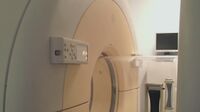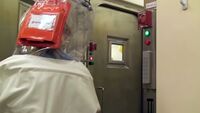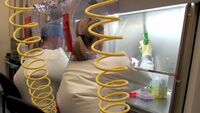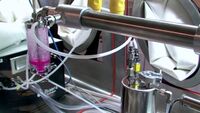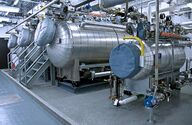مستوى السلامة الحيوية
مستوى السلامة الحيوية (إنگليزية: Biosafety level، أو مستوى حماية/الممرض (إنگليزية: pathogen/protection level)، هي مجموعة احتياطيات الاحتواء الحيوي اللازمة لعزل العوامل الخطرة الخطرة في منشأة معملية مغلقة. تتراوح مستويات الاحتواء من أدنى مستوى للسلامة الحيوية 1 (BSL-1) إلى أعلى مستوى في المستوى 4 (BSL-4). في الولايات المتحدة، حددت مراكز السيطرة على الأمراض والوقاية منها هذه المستويات.[2] في الاتحاد الأوروپي، يتم تحديد مستويات السلامة الحيوية نفسها ضمن توجيهات.[3] في كندا تُعرف المستويات الأربعة بمستويات الاحتواء.[4] أحيانًا يتم منح التسهيلات التي تحمل هذه التعيينات مثل P1 حتى P4 (للعوامل الممرضة أو مستوى الحماية)، كما هو الحال في المصطلح "مختبر P3".[5]
في أدنى مستوى من السلامة الحيوية، قد تتضمن الاحتياطات غسل اليدين بشكل منتظم ومعدات حماية قليلة. في مستويات السلامة الحيوية الأعلى، قد تشمل الاحتياطات أنظمة تدفق الهواء، وغرف احتواء متعددة، وحاويات مغلقة، بدلة الضغط الإيجابي، والبروتوكولات المعمول بها لجميع الإجراءات، وتدريب الموظفين المكثف، ومستويات عالية من الأمن للتحكم في الوصول إلى المرفق. أفادت وزارة الصحة الكندية أنه حتى عام 1999 تم تسجيل أكثر من 5000 حالة من العدوى المعملية العرضية و190 حالة وفاة.[6]
التاريخ
تم تصميم أول نموذج أولي من الفئة الثالثة (أقصى احتواء) خزانة السلامة الحيوية في عام 1943 من قبل هوبرت كايمف الأصغر، الذي كان في ذلك الوقت جندياً في الجيش الأمريكي، تحت إشراف أرنولد ويدم، (1944-1969) مدير الصحة والسلامة الصناعية في مختبرات الحرب الحيوية التابعة للجيش الأمريكي، معسكر دتريك، ماريلاند. سئم كايمف من واجباته في الشرطة العسكرية بمعسكر دتريك وتمكن من الانتقال إلى قسم الصفائح المعدنية الذي يعمل مع المقاول، شركة هـ. ك. فرگسون.[7]
في 18 أبريل 1955، التقى أربعة عشر ممثلاً في معسكر دتريك في فريدريك بولاية ماريلاند. كان الاجتماع لتبادل المعرفة والخبرات فيما يتعلق بالسلامة الحيوية، وقضايا السلامة الكيميائية والإشعاعية والصناعية التي كانت شائعة في العمليات بمختبرات الحرب الحيوية الرئيسية الثلاثة التابعة للجيش الأمريكي.[8] بسبب الآثار المحتملة للعمل الذي تم إجراؤه في مختبرات الحرب الحيوية، اقتصرت المؤتمرات على حاملي التصريح الأمني الأعلى. ابتداءً من عام 1957، تم التخطيط لهذه المؤتمرات لتشمل جلسات غير سرية بالإضافة إلى جلسات سرية لتمكين مشاركة أوسع لمعلومات السلامة الحيوية. ومع ذلك، لم تعقد المؤتمرات حتى عام 1964 في منشأة حكومية غير مرتبطة ببرنامج الحرب الحيوية.[9] على مدى السنوات العشر التالية، تنامت مؤتمرات السلامة الحيوية لتشمل ممثلين من جميع الوكالات الفدرالية التي رعت أو أجرت أبحاثًا مع الكائنات الحية الدقيقة المسببة للأمراض. بحلول عام 1966، بدأت يضم ممثلين عن الجامعات والمختبرات الخاصة والمستشفيات والمجمعات الصناعية. طوال السبعينيات، استمرت المشاركة في المؤتمرات في التوسع وبحلول عام 1983 بدأت المناقشات بشأن إنشاء منظمة رسمية.[9] تأسست الجمعية الأمريكية للسلامة الحيوية رسمياً عام 1984 وتمت صياغة دستورها ولوائحها في نفس العام. اعتبارًا من عام 2008، كانت الجمعية تضم حوالي 1600 عضو في جمعيتها المهنيةا.[9]
في عام 1977، سأل جيم پيكوك من الأكاديمية الأسترالية للعلوم بيل سنودون، رئيس منظمة الكومنولث للبحوث العلمية والصناعية في ذلك الوقت قالب:Huh إذا كان بإمكانه الحصول على توجيهات المعاهد الوطنية للصحة الأمريكية والبريطانية الصادرة حديثًا حيث تمت مراجعة المتطلبات المكافئة لتطوير البنية التحتية للاحتواء الحيوي من قبل موظفي المعمل الأسترالي للصحة الحيوانية (AAHL) بهدف التوصية باعتماد واحد منهم من قبل السلطات الأسترالية. أجرى المراجعة بيل كورنو، مدير مشروع CSIRO AAHL، ومهندس CSIRO آرثر جنكينز. قاموا بصياغة النتائج لكل مستوى من مستويات الأمان. تم تصنيف AAHL من الناحية النظرية على أنها "تتجاوز مستوى السلامة الرابع بدرجة كبيرة". تم تبنيها من قبل الأكاديمية الأسترالية للعلوم وأصبحت أساس التشريع الأسترالي. افتتح في عام 1985 بتكلفة 185 مليون دولار، تم بناؤه على كوريو أوڤال.[10] المعمل الأسترالي للصحة الحيوانية هو معمل سلامة حيوية من المستوى 4.
المستويات
مستوى السلامة الحيوية 1
مستوى السلامة الحيوية 1 (BSL-1) مناسب للعمل مع عوامل جيدة التوصيف والتي لا تسبب المرض لدى البشر الأصحاء. بشكل عام، يجب أن تشكل هذه العوامل الحد الأدنى من المخاطر المحتملة على موظفي المختبر والبيئة.[11] في هذا المستوى، تكون الاحتياطات محدودة بالنسبة إلى المستويات الأخرى. يجب على العاملين في المختبر غسل أيديهم عند دخول المختبر والخروج منه. يمكن إجراء البحث باستخدام هذه العوامل على مناضد المختبرات المفتوحة القياسية دون استخدام معدات احتواء خاصة. ومع ذلك، فإن الأكل والشرب محظوران عمومًا في مناطق المختبر.[11] يجب إزالة التلوث من المواد التي يُحتمل أن تكون معدية قبل التخلص منها، إما عن طريق إضافة مادة كيميائية مثل المبيض أو الأيزوپروپانول أو عن طريق التغليف لإزالة التلوث في مكان آخر.[11]
معدات الحماية الشخصية مطلوبة فقط للظروف التي قد يتعرض فيها الأفراد لمواد خطرة.[11] يجب أن يكون لمختبرات BSL-1 باب يمكن قفله للحد من الوصول إلى المختبر. ومع ذلك، ليس من الضروري عزل مختبرات BSL-1 عن المبنى العام.[12]
هذا المستوى من السلامة الحيوية مناسب للعمل مع عدة أنواع من الكائنات الحية الدقيقة بما في ذلك السلالات غير المسببة للأمراض من الإشريشيا المعوية، المكورة العنقودية، العصوية الرقيقة، فطريات الخميرة وكائنات أخرى لا يُشتبه في أنها تساهم في الإصابة بالأمراض البشرية.[13] نظرًا للسهولة والأمان النسبيين في الحفاظ على مختبر BSL-1، فهذه هي أنواع المختبرات المستخدمة عمومًا كمساحات تعليمية للمدارس الثانوية والكليات.[12]
مستوى السلامة الحيوية 2
في هذا المستوى، تتبع جميع الاحتياطات المستخدمة في مستوى السلامة الحيوية 1، وتتخذ بعض الاحتياطات الإضافية. يختلف BSL-2 عن BSL-1 في التالي:
- * يخضع موظفو المختبر لتدريب خاص في التعامل مع العوامل المسببة للأمراض ويوجههم علماء حاصلون على تدريب متقدم.
- يقتصر دخول المختبر على وقت إجراء العمل.
- تتخذ احتياطات قصوى مع العناصر الحادة الملوثة.
- تجرى بعض الإجراءات التي يمكن أن تنشأ فيها الجسيمات المعدية أو الرذاذ في خزانة السلامة الحيوية أو غيرها من معدات الاحتواء المادي.[11]
مستوى السلامة الحيوية 2 مناسب للعمل الذي يتضمن عوامل ذات مخاطر متوسط محتمل على الأفراد والبيئة. [12] ويشمل هذا الجراثيم المختلفة التي تسبب أمراضاً خفيفة للإنسان، أو يصعب التعرض لها عن طريق الرذاذ في بيئة معملية.[14] تشمل الأمثلة ڤيروسات التهاب الكبد الوبائي أ، ب، وج، ڤيروس نقص المناعة البشرية (HIV)، السلالات الممرضة للإشريشيا المعوية، المكورة العنقودية، السالمونلا، المتصورة المنجلية، والمقوسة الگوندية.[14][15]
مستوى السلامة الحيوية 3

مستوى السلامة الحيوية 3 مناسب للعمل الذي يشمل الجراثيم التي يمكن أن تسبب مرضًا خطيرًا ومميتًا عبر مسار الاستنشاق.[11] يمكن القيام بهذا النوع من العمل في مرافق إكلينيكية أو تشخيصية أو تعليمية أو بحثية أو إنتاجية. [12] في هذه الحالة، تتبع الاحتياطات المتخذة في مختبرات BSL-1 وBSL-2، بالإضافة إلى التدابير الإضافية التي تشمل:
- توفير المراقبة الطبية لجميع العاملين في المختبر وتقديم التطعيمات المناسبة (إن وجدت) لتقليل مخاطر الإصابة العرضية أو غير الملحوظة.[11]
- يجب اتباع جميع الإجراءات المتعلقة بالمواد المعدية داخل قمرة السلامة الحيوية.[11]
- يجب على العاملين في المختبر ارتداء ملابس واقية صلبة (أي ملابس تربط في الخلف) لا يمكن ارتداؤها خارج المختبر ويجب التخلص منها أو تطهيرها بعد كل استخدام.[11]
- يجب صياغة دليل السلامة الحيوية الخاص بالمختبر والذي يوضح بالتفصيل كيفية عمل المختبر وفقًا لجميع متطلبات السلامة.[11]
بالإضافة إلى ذلك، يجب أن يكون للمنشأة التي تضم مختبر BSL-3 مميزات معينة لضمان الاحتواء المناسب. يجب فصل مدخل المختبر عن مناطق المبنى ذات التدفق المروري غير المقيد.[11] بالإضافة إلى ذلك، يجب أن يكون المختبر خلف مجموعتين من الأبواب ذاتية الإغلاق (لتقليل مخاطر هروب الرذاذ). [12] يجب أن يكون بناء المختبر سهل التنظيف. لا يُسمح بالسجاد، وأي طبقات في الأرضيات والجدران والأسقف محكمة الغلق للسماح بتنظيفها وتطهيرها بسهولة.[11] بالإضافة إلى ذلك، يجب إغلاق النوافذ وتركيب نظام تهوية يجبر الهواء على التدفق من المناطق "النظيفة" في المختبر إلى المناطق التي يتم فيها التعامل مع العوامل المعدية.[11] يجب تنقية الهواء من المختبر قبل إعادة تدويره.[11] حددت دراسة أجراها صحفيون في "يو إس إيه توداي" عام 2015 أكثر من 200 موقع معملي في الولايات المتحدة اعتمدت فيه مستويات السلامة الحيوية 3 أو 4.[16] تقدم وقائع ورشة عمل حول "تطوير القواعد لتوفير المختبرات الحيوية في السياقات منخفضة الموارد" قائمة بمختبرات BSL-3 في تلك البلدان.[17] يستخدم المستوى 3 من السلامة الحيوية بشكل شائع في أعمال البحث والتشخيص التي تشمل الجراثيم المختلفة التي يمكن أن تنتقل عن طريق الرذاذ و/أو تسبب مرضًا شديدًا. يشمل هذا الفرنسيسلة التولارية، المتفطرة السلية، المتدثرة الببغائية، ڤيروس التهاب المخ الخيلي الڤنزويلي، ڤيروس التهاب المخ الخيلي الشرقي، سارس-كوڤ-1، مرس-كوڤ، الكوكسيلة البورنيتية، ڤيروس حمى الوادي المتصدع، ريكتسية ريكتسي، أنواع مختلفة من البروسيلا، التشيكونگونيا، ڤيروس الحمى الصفراء، ڤيروس غرب النيل، اليرسينيا الطاعونية،[15] وسارس-كوڤ-2.[18]
مستوى السلامة الحيوية 4
مستوى السلامة الحيوية 4 (BSL-4) هو أعلى مستوى من احتياطات السلامة الحيوية، وهو مناسب للعمل مع العوامل التي يمكن أن تنتقل بسهولة عبر الرذاذ داخل المختبر وتسبب للبشر أمراضًا من خطيرة إلى قاتلة والتي لا تتوفر لها لقاحات أو علاجات. يتم إنشاء مختبرات BSL-4 عمومًا لتكون إما مختبرات قمرة أو مختبرات للبدلات الواقية. في مختبرات القمرة، يجب أن يجرى كل العمل داخل قمرة السلامة الحيوية من الدرجة الثالثة. يجب تطهير المواد التي تغادر القمرة بالمرور عبر الموصدة أو خزان المطهر. يجب أن تحتوي القمرات نفسها على حواف غير ملحومة للسماح بالتنظيف السهل. بالإضافة إلى ذلك، يجب أن تكون القمرة وجميع المواد بداخلها خالية من الحواف الحادة لتقليل مخاطر تلف القفازات. في معمل البدلات الواقية، يجب أن يتم كل العمل في قمرة السلامة الحيوية من الدرجة الثانية من قبل أفراد يرتدون بدلة ضغط إيجابي. من أجل الخروج من مختبر BSL-4، يجب على الأفراد المرور عبر دش كيميائي لإزالة التلوث، ثم غرفة لإزالة بدلة الضغط الإيجابي، يليها دش شخصي. يقتصر الدخول إلى مختبر BSL-4 على الأفراد المدربين والمصرح لهم، ويجب تسجيل جميع الأشخاص الذين يدخلون إلى المختبر ويخرجون منه.[11]
كما هو الحال مع مختبرات BSL-3، يجب فصل مختبرات BSL-4 عن المناطق التي تشهد حركة مرور غير مقيدة. بالإضافة إلى ذلك، يتم التحكم بإحكام في تدفق الهواء لضمان تدفق الهواء دائمًا من المناطق "النظيفة" في المختبر إلى المناطق التي يتم فيها العمل مع العوامل المعدية. يجب أن يستخدم مدخل مختبر BSL-4 أيضًا قفل الهواء لتقليل احتمالية إزالة الرذاذ من المختبر. يجب أيضًا تطهير جميع نفايات المختبر، بما في ذلك الهواء والماء والقمامة المصفاة قبل إخراجها من المرفق.[11]
تُستخدم مختبرات السلامة الحيوية من المستوى 4 في أعمال التشخيص والبحث عن مسببات الأمراض سهلة الانتقال والتي يمكن أن تسبب أمراضًا قاتلة. وتشمل هذه عددًا من الڤيروسات المعروف أنها تسبب الحمى النزفية الڤيروسية مثل ڤيروس ماربورگ وڤيروس إيبولا وڤيروس لاسا وحمى الكونغو-القرم النزفية. تشمل مسببات الأمراض الأخرى التي يتم التعامل معها في BSL-4 ڤيروس هندرا، وڤيروس نيپاه، وبعض الڤيروسات المصفرة. بالإضافة إلى ذلك، غالبًا ما يتم التعامل مع مسببات الأمراض سيئة التوصيف والتي تبدو مرتبطة ارتباطًا وثيقًا بمسببات الأمراض الخطيرة على هذا المستوى حتى يتم الحصول على بيانات كافية إما لتأكيد استمرار العمل على هذا المستوى، أو للسماح بالعمل معها على مستوى أدنى.[15] يستخدم هذا المستوى أيضًا للعمل مع ڤيروس ڤاريولا، العامل المسبب للجدري، على الرغم من أن هذا العمل يجرى فقط في مراكز السيطرة على الأمراض والوقاية منها في أتلانتا الأمريكية، ومركز أبحاث الدولة لعلم الڤيروسات والتكنولوجيا الحيوية في كولتسوڤو الروسية.[19]
الفحص المنتظم لبدلات الضغط الإيجابي لتحديد أي تسرب[20]
يفصل أنبوب الاحتواء الدائري طاولة المريض في المنطقة "الساخنة" (وجود العامل الممرض) عن المنطقة "الباردة" حول جهاز التصوير بالرنين المغناطيسي.
داخل قمرة سلامة حيوية من الدرجة الثالثة مزودة بمنصة تحكم بالرذاذ.
نظام إزالة التلوث من النفايات السائلة في معمل BSL-4 تابع للمعهد الوطني للحساسية والأمراض المعدية.
مرافق المستوى 4 لعينات من خارج الأرض
مهمات إرجاع العينات التي تهدف لإعادة عينات تم الحصول عليها من جرم من الفئة الخامسة إلى الآرض، يجب معالجتها داخل منشآت سلامة حيوية من الدرجة 4. لأن مرافق BSL-4 الموجودة في العالم لا تملك المتطلبات المعقدة لضمان الحفاظ على الأرض والعينة وحمايتها في وقت واحد،[21] يوجد حاليًا مقترحان على الأقل لبناء منشأة BSL-4 مخصصة لمعالجة المواد المقيدة (التي يحتمل أن تكون مواد من خارج الأرض خطرة حيوياً.
الأول هو المرفق الأوروپي لمعالجة العينات (ESCF)،[22][23] المقترح بناؤه في ڤيينا، والذي سيعالج العينات الغير مقيدة بالإضافة إلى منصة BSL-4 لمعالجة العينات المواد المقيدة التي تم الحصول عليها من أجرام من الفئة الخامسة مثل المريخ، أوروپا، وإنسلادوس.[22] The other proposal is by NASA and is tentatively known as the Mars Sample-Return Receiving facility (MSRRF).[24] تم تقديم ثلاثة تصميمات مختلفة على الأقل في عام 2009.[21] إذا تم تمويل هذا المرفق الأمريكي، فمن المتوقع أن يستغرق من 7 إلى 10 سنوات من التصميم حتى اكتماله،[25][26] ويوصى بعامين إضافيين حتى يصبح الموظفون ماهرين ومعتادون على المرافق.[25] تقوم ناسا أيضًا بتقييم اقتراح عام 2017 لبناء منشأة متنقلة ومعيارية BSL-4 لتأمين عينة من كبسولة العودة في موقع الهبوط لإجراء تحليلات أولية للمخاطر الحيوية.[27] بعد الانتهاء من اختبار الخطر الحيوي، يمكن اتخاذ قرارات لتعقيم العينة أو نقلها كلها أو أجزاء منها إلى منشأة تخزين الحجر الصحي الدائم في أي مكان بالعالم.[27] يجب أن تكون أنظمة هذه المرافق قادرة على احتواء مخاطر حيوية غير معروفة، حيث إن أحجام أي عضية دقيقة مفترضة غير معروفة. من الناحية المثالية، يجب أن ترشح الجسيمات حتى 10 نانومتر، وإطلاق جسيم 50 نانومتر أو أكبر أمر غير مقبول تحت أي ظرف من الظروف.[28]
قائمة مرافق المستوى 4
| البلد | الموقع | الاسم | تاريخ التأسيس |
الوصف |
|---|---|---|---|---|
| الأرجنتين | بوينس أيرس | National Service of Healthcare and Agriculture Quality (SENASA) | Diagnostic laboratory for foot-and-mouth disease.[29] | |
| أستراليا | گيلونگ، ڤكتوريا | Australian Centre for Disease Preparedness | 1985 | Capable of housing from large experimental animals to insects under conditions that exceed all BSL 4 requirements. The antecedent of all such facilities developed since the 1980s. Arguably the most researched design and construction project ever. AAHL is subdivided into a number of isolation zones that can be managed at differing containment levels concurrently. CSIRO AAHL Project Manager and Architect, William Curnow, provided technical reviews to Canadian, Indian, UK and French Authorities and consulted with Dr Jerry Callis [PIADC] to UN FAO on matters of bio-containment. Formerly known as the Australian Animal Health Laboratory (AAHL) and renamed to Australian Centre for Disease Preparedness April 2020 |
| ملبورن, ڤكتوريا | جامعة ملبورن – Doherty Institute for Infection and Immunity | 2014 | Diagnostic reference lab.[30][31] | |
| المعمل الوطني عالي التأمين | Operates under the auspice of the Victoria Infectious Diseases Reference Laboratory.[32] | |||
| البرازيل | پدرو ليوپولدو، ميناز جرايس | Laboratório Nacional Agropecuário de Minas Gerais (Lanagro/MG) | 2014 | Focus on Agropecuary diseases and diagnostics.[33] |
| كندا | وينيپگ، مانيتوبا | المعمل الوطني لعلم الأحياء الدقيقة | 1999[34] | Located at the Canadian Science Centre for Human and Animal Health, it is jointly operated by the Public Health Agency of Canada and the Canadian Food Inspection Agency.[35] |
| الصين | وهان، هوبـِيْ | معهد ووهان لعلم الڤيروسات التابع للأكاديمية الصينية للعلوم | 2015 | Wuhan Institute of Virology has existed since 1956 and already hosted BSL-3 laboratories. A BSL-4 facility was completed in 2015, and became the first BSL-4 laboratory in China.[36] |
| هاربين، خـِيْلونگجيانگ | Harbin Veterinary Research Institute of the Chinese Academy of Agricultural Sciences | 2018 | Harbin Veterinary Research Institute researches prevention and control of major infectious diseases. China's second, and the first for large animals, BSL-4 lab.[37] | |
| التشيك | Těchonín, Pardubice Region | Biological Defense Center | 1971, rebuilt 2003–2007 | Hospital and research facility. Located at the Centrum biologické ochrany (Biological Defense Center). Operated by Army of the Czech Republic.[38] |
| فرنسا | Brétigny-sur-Orge, Essonne | French Armed Biomedical Research Institute, French Defence Health Service | French Army laboratory.[39] | |
| ليون, Metropolis of Lyon | Jean Mérieux BSL-4 Laboratory | 1999 | Built and owned by the Fondation Mérieux. Since 2004, operated by INSERM.[40] | |
| Vert-le-Petit, Essonne | Laboratoire de la DGA | 2013 | Operated by the Ministry of Defense.[41] | |
| الگابون | Franceville, Haut-Ogooué Province | Centre International de Recherches Médicales de Franceville | This facility is operated by a research organization supported by both Gabonese (mainly) and French governments, and is West Africa's only P4 lab (BSL-4).[42] | |
| ألمانيا | برلين | معهد روبرت كوخ | 2015 | Diagnostic and experimental lab facility.[43] |
| هامبورگ | Bernhard Nocht Institute for Tropical Medicine | 2014 | Part of the Leibniz Center Infection. National reference lab for tropical viruses.[44] | |
| Isle of Riems, Greifswald, Mecklenburg-Vorpommern | Friedrich Loeffler Institute | 2010 | Focus on animal viral diseases and diagnostics.[45] | |
| ماربورگ، هسه | Philipps University of Marburg | 2008 | Focuses on hemorrhagic fever viruses.[46] | |
| المجر | بوداپشت | المركز الوطني لعلم الأوبئة | 1998 | Division of Virology operates three WHO National Reference Laboratories. The BSL-4 biosafety laboratory provides a modern means to process dangerous imported zoonotic viral pathogens.[47] |
| پتش | معهد پتش | 2016 | Opened in 2016, part of "Szentágothai János Kutatóközpont". | |
| الهند | Bhopal, Madhya Pradesh | High Security Animal Disease Laboratory (HSADL) | 1998 | This facility deals especially to zoonotic organisms and emerging infectious disease threats.[48] |
| حيدر أباد, Telangana | Centre for Cellular and Molecular Biology | 2009 | National BSL-4 Containment Facility for Human Infectious Diseases.[49] | |
| Pune, Maharashtra | National Institute of Virology | 2012 | India's most advanced BSL-4 category lab.[50] | |
| إيطاليا | روما, Lazio | Istituto Nazionale per le Malattie Infettive | 1997 | The "National Institute of Infectious Diseases" used to operate within the Lazzaro Spallanzani hospital; the facility is now independent and is home to five BSL-3 labs as well as a single BSL-4 laboratory, which was completed in 1997.[51] |
| ميلانو، لومبارديا | Ospedale Luigi Sacco | 2006 | ||
| اليابان | Musashimurayama, طوكيو | المعهد الوطني للأمراض المعدية | 2015 | Located at National Institute for Infectious Diseases, Department of Virology I. Built in 1981; operated at BSL-3 until 2015 due to opposition from nearby residents.[52] |
| Tsukuba, Ibaraki Prefecture | Institute of Physical and Chemical Research (RIKEN) | 1984 | Facility completed in 1984 but not operated as BSL-4 due to local opposition.[53] | |
| الفلپين | New Clark City, Capas, Tarlac | Virology Institute of the Philippines | 2024 (expected) | First BSL-4 Lab in the Philippines when completed.[54] |
| روسيا | Koltsovo, Novosibirsk Oblast | State Research Center of Virology and Biotechnology (VECTOR) | One of two WHO-approved facilities for work on variola virus.[19] | |
| سنغافورة | سنغافورة | DSO National Laboratories | نهاية-2025 (متوقع) | First BSL-4 Lab in Singapore when completed.[55] |
| جنوب أفريقيا | Johannesburg, Gauteng | National Institute for Communicable Diseases | 2002 | [56] |
| كوريا الجنوبية | Cheongju, North Chungcheong Province | Korea Centers for Disease Control and Prevention | 2017 | أول معمل BSL-4 في كوريا الجنوبية. |
| السويد | Solna, Stockholm County | Public Health Agency of Sweden | 2001 | The only BSL-4 facility in the Nordic region. Constructed for research and diagnostics of hemorrhagic fever viruses.[57] |
| سويسرا | جنيڤ، كانتون جنيڤ | مستشفى جنيڤ الجامعي | "Glove box" type laboratory; primarily for handling clinical samples.[58] | |
| Spiez, كانتون برن | Spiez Laboratory | 2013 | Run by Federal Office for Civil Protection and the Federal Department of Defence, Civil Protection and Sports.[59] | |
| Mittelhäusern, كانتون برن | The Institute of Virology and Immunology IVI[60] | Part of the Food Safety and Veterinary Office (FSVO).[61] Primary purpose is diagnostics of highly pathogenic viruses.[59] | ||
| تايوان | جامعة الدفاع الوطني | معهد الطب المناعي | 1983 | [62] |
| المملكة المتحدة | كامدن، لندن الكبرى | معهد فرانسيس كريك | 2015 | Has BSL-4 space but does not work on human pathogens.[63] |
| Colindale، لندن الكبرى | Public Health England's Centre for Infections | Department of Health laboratory. Diagnostics for various viral diseases.[64] Part of the European Network of Biosafety-Level-4 Laboratories.[65] | ||
| Mill Hill، لندن الكبرى | المعهد الوطني للأبحاث الطبية | Medical Research Council laboratory. Research and diagnostics for highly pathogenic viruses. Closed in 2017 and work moved to the Francis Crick Institute. Site demolished in 2018. [64] | ||
| Potters Bar, Hertfordshire | National Institute for Biological Standards and Control | Department of Health and Home Office laboratory. Develop assays and reagents for research on virulent pathogens.[64] | ||
| Addlestone, Surrey | Animal and Plant Health Agency | Department for Environment, Food and Rural Affairs laboratory. Diagnostics and research for animal diseases.[64] | ||
| Pirbright, Surrey | معهد الصحة الحيوانية | Biotechnology and Biological Sciences Research Council laboratory. Research on highly pathogenic animal diseases.[64] | ||
| Merial Animal Health | Private lab. Produces vaccines against foot and mouth disease and bluetongue disease.[64] | |||
| Porton Down, Wiltshire | Centre for Emergency Preparedness and Response | Department of Health laboratory. Diagnostics and research for haemorrhagic fever viruses.[64] Part of the European Network of Biosafety-Level-4 Laboratories.[65] | ||
| معمل علوم وتكنولوجيا الدفاع | Ministry of Defence laboratory. Focuses on protection from biological weapons.[64] | |||
| الولايات المتحدة | فورت كولنز، كلورادو | Centers for Disease Control and Prevention, Division of Vector Borne Diseases | A BSL 3/4 facility that operates in connection with some of Colorado State University's biomedical research programs. The location specializes in arboviral and bacterial diseases.[66] | |
| أطلانطا، جورجيا | مراكز السيطرة على الأمراض والوقاية منها | Currently operates in two buildings. One of two facilities in the world that officially hold smallpox.[19] | ||
| جامعة ولاية جورجيا | 1997 | Research focus on B virus.[67] | ||
| منهاتن، كنساس | National Bio and Agro-Defense Facility (NBAF), Kansas State University | 2022 (متوقع) | Under construction. Facility to be operated by the Department of Homeland Security, and replace the Plum Island Animal Disease Center. Expected to be operational by 2022–2023.[68] | |
| بتسادا، ماريلاند | المعاهد الوطنية للصحة (NIH) | Located on the NIH Campus, it currently only operates with BSL-3 agents.[69] | ||
| فورت دتريك، ماريلاند | مرفق الأبحاث المتكاملة | Operated by National Institute of Allergy and Infectious Diseases (NIAID). Focuses on animal models of human diseases.[70] | ||
| National Biodefense Analysis and Countermeasures Center | Operated by the Department of Homeland Security. Focus on potential bioterrorism threats.[71] | |||
| US Army Medical Research Institute of Infectious Diseases (USAMRIID) | 1969 | Run by the U.S. Army. Research focuses on biological threats to the U.S. military.[72][73] | ||
| بوسطن، مساتشوستس | National Emerging Infectious Diseases Laboratory (NEIDL), Boston University | Built 2008, Opened 2012,[74] BSL-4 Approval in 2017 [75] | Focus on potential threats to public health.[76] | |
| هاميلتون، مونتانا | Rocky Mountain Laboratories Integrated Research Facility | 2008 | NIAID laboratory. Focus on vector-borne diseases.[77] | |
| گالڤستون، تكساس | معمل گالڤستون الوطني, National Biocontainment Facility | Opened in 2008, facility is operated by the University of Texas Medical Branch.[78] | ||
| معمل شوپ | 2004 | Operated by the University of Texas Medical Branch.[79] | ||
| سان أنطونيو، تكساس | معهد تكساس لأبحاث الطب الحيوي | 1999 | The only privately owned BSL-4 lab in the US.[80] | |
| ريتشموند، ڤرجينيا | Virginia Division of Consolidated Laboratories | 2003 | A BSL-4 lab that also acts as a BSL-3 lab.[81] |
مخاوف السلامة
في خطاب ألقاه في ديسمبر 2014، أشار هارڤي فاينبرگ إلى أن "فكرة أخرى مهمة جدًا تم تطويرها في اجتماع هانوڤر كانت حقيقة أنه عندما نتحدث عن سلامة المختبرات، فإن التصنيفات التقليدية للأخطار للحيوية لدرجة BSL-2 و-3 و-4 ليست غنية بالمعلومات أو محددة بما يكفي لتزويدنا بالتأكيدات التي نرغب فيها بشأن أمان أي مختبر. يغطي ملصق مثل BSL-3 مجموعة متنوعة من الإجراءات والممارسات المختبرية. نحتاج إلى التفكير في السلامة البيولوجية من حيث الكل أنظمة البناء والتشغيل والتدريب والبروتوكولات والقياس والمراقبة التي تخلق درجة من الأمان في عمل المختبرات لغرض معين".[82]
سلطت دراسة أجرتها جمعية مكافحة البعوض والنواقل في ولاية كارولينا الشمالية (NCMVCA) الضوء على مخاوف تتعلق بالسلامة. في الولايات المتحدة، يمكن تمويل المختبرات من قبل الحكومة الفدرالية أو الحكومات الولائية المؤسسات الخاصة أو المنظمات الغير هادفة للربح أو الأكاديميات. تمثل الأخيرة 72% من التمويل. لا توجد وكالة مراقبة مركزية مسؤولة عن مراقبة المختبرات وتختلف المعايير وفقًا للتمويل وعمر المختبر وتعتمد على الحجم وما إذا كان معتمدًا من SA.[83]
يجب أن تلتزم المختبرات عالية الاحتواء المسجلة لدى مراكز السيطرة على الأمراض والوقاية منها (CDC) وبرنامج وكيل وزارة الزراعة الأمريكية (USDA) المحدد بمعايير وزارة الدفاع.[84] لا توجد وكالة فدرالية واحدة، وفقًا لردود 12 وكالة على استطلاع GSA، لديها مهمة تتبع العدد الإجمالي لمختبرات BSL-3 و BSL-4 في الولايات المتحدة. هذا يعني أنه لا توجد وكالة مسؤولة عن تحديد المخاطر المرتبطة بانتشار هذه المعامل.[85]
انظر أيضاً
- فريق العزل الطبي الجوي
- سلامة حيوية
- إحتواء حيوي
- مخاطر حيوية
- سترة المواد الخطرة
- التلوث بين الكواكب
- شكبة الاستجابة المعملية
- قائمة حوادث الأمن الحيوي في المختبرات
- هندسة السلامة
- هندسة الأمن
- عامل اختيار
المصادر
- ^ أ ب "Integrated Research Facility". niaid.nih.gov. NIAID. Archived from the original on 28 November 2014. Retrieved 14 November 2014.
- ^ Chosewood LC, Wilson DE, eds. (2009). Biosafety in Microbiological and Biomedical Laboratories (5th ed.). Centers for Disease Control and Prevention. ISBN 978-0-1608-5042-4. Retrieved 1 April 2020.
- ^ Directive 2000/54/EC of the European Parliament and of the Council of 18 September 2000 on the protection of workers from risks related to exposure to biological agents at work (seventh individual directive within the meaning of Article 16(1) of Directive 89/391/EEC)
- ^ Canada, Public Health Agency of. "Chapter 2: The Laboratory Biosafety Guidelines: 3rd Edition 2004 – Biological safety - Canada.ca". www.canada.ca. Archived from the original on 23 February 2018. Retrieved 7 May 2018.
- ^ Laboratory Safety Monograph: A Supplement to the NIH Guidelines for Recombinant DNA Research. Department of Health, Education, and Welfare, Public Health Service, National Institutes of Health, National Cancer Institute, Office of Research Safety. 1978. passim.
- ^ "Biosafety at Ryerson" (PDF). Ryerson University Facilities Management and Design. Retrieved 4 February 2021.
- ^ Covt, Norman M. (1997), “A History of Fort Detrick, Maryland” Archived 2008-09-22 at the Wayback Machine, 3rd edition. Kaempf retired from Fort Detrick in 1994, having completed more than 50 years service. He was chief of the mechanical branch, Directorate of Engineering and Housing.
- ^ Manuel S. Barbeito; Richard H. Kruse. "A History of the American Biological Safety Association". American Biological Safety Association. Archived from the original on 2008-06-20. Retrieved 2008-08-14.
- ^ أ ب ت "American Biological Safety Association Collection : NAL Collections : National Agricultural Library". United States Department of Agriculture: National Agricultural Library. 2009-02-11. Archived from the original on 2009-02-27. Retrieved 2009-02-11.
- ^ "CSIRO: Geelong - Australian Animal Health Laboratory".
- ^ أ ب ت ث ج ح خ د ذ ر ز س ش ص ض ط "Section IV-Laboratory Biosafety Level Criteria". Biosafety in Microbiological and Biomedical Laboratories, 5th ed (PDF). U.S. Department of Health and Human Services. December 2009. pp. 30–59. Archived (PDF) from the original on 9 April 2016. Retrieved 2 April 2016.
- ^ أ ب ت ث ج Richmond JY. "The 1, 2, 3's of Biosafety Levels" (PDF). Archived (PDF) from the original on 19 March 2015. Retrieved 2 April 2016.
- ^ "Health & Safety Manual - Biological Safety". Columbia University Environmental Health and Safety. Archived from the original on 27 March 2016. Retrieved 2 April 2016.
- ^ أ ب "Section III-Principles of Biosafety". Biosafety in Microbiological and Biomedical Laboratories, 5th ed (PDF). U.S. Department of Health and Human Services. December 2009. pp. 22–28. Archived (PDF) from the original on 10 March 2016. Retrieved 9 April 2016.
- ^ أ ب ت For a list of infectious agents and the recommended biosafety level at which they should be studied, see "Section VIII-Agent Summary Statements". Biosafety in Microbiological and Biomedical Laboratories, 5th ed. U.S. Department of Health and Human Services. December 2009. pp. 123–289. Archived (PDF) from the original on 27 March 2016. Retrieved 9 April 2016.
- ^ Penzenstadler, Nick (28 May 2015). "State incidents highlight bioterror lab concerns". Post Crescent. USA Today Network.
- ^ "APPENDIX E LIST OF LABS IDENTIFIED IN LOW-RESOURCE COUNTRIES". National Academy of Sciences. 2019. Retrieved 4 February 2021.
- ^ "Interim Laboratory Biosafety Guidelines for Handling and Processing Specimens Associated with Coronavirus Disease 2019 (COVID-19)". Coronavirus Disease 2019 (COVID-19) Lab Biosafety Guidelines. Centers for Disease Control and Prevention. Retrieved 1 April 2020.
- ^ أ ب ت "Section VIII-Agent Summary Statements". Biosafety in Microbiological and Biomedical Laboratories, 5th ed (PDF). U.S. Department of Health and Human Services. December 2009. p. 219. Archived (PDF) from the original on 13 May 2016. Retrieved 4 May 2016.
- ^ Seligson, Susan (7 March 2013). "Video Offers Glimpse of Biosafety Level 4 Lab Science webcast "threads the NEIDL"". BU Today. Archived from the original on 10 December 2014. Retrieved 5 December 2014.
- ^ أ ب How to Protect Mars Samples on Earth. Jeremy Hsu, Space.com. 3 December 2009.
- ^ أ ب EURO EURO-CARES Extraterrestrial Sample Curation Facility: Architecture as an enabler of science. (PDF) Aurore Hutzler, Emre Kilic, Allan Bennett, Ludovic Ferrière. 47th International Conference on Environmental Systems, 16-20 July 2017, Charleston, South Carolina. Document ICES-2017-323.
- ^ EURO-CARES. European Curation of Astromaterials Returned from Exploration of Space. Accessed: 25 September 2018.
- ^ Ronald Atlas (2002). "Mars Sample Return Receiving Facility" (PDF). NASA.
- ^ أ ب 'Assessment of Planetary Protection Requirements for Mars Sample Return Missions'. National Research Council. 2009. p. 59.
- ^ Mars Sample Return: Issues and Recommendations (Planetary Protection Office Summary) Task Group on Issues in Sample Return. National Academies Press, Washington, DC (1997)
- ^ أ ب Mobile/Modular BSL-4 Facilities for Meeting Restricted Earth Return Containment Requirements. M. J. Calaway, F. M. McCubbin, J. H. Allton, R. A. Zeigler, and L. F. Pace. (PDF) NASA. 2017.
- ^ European Science Foundation - Mars Sample Return backward contamination - Strategic advice and requirements Archived 2016-06-02 at the Wayback Machine
- ^ "Risk Analysis:Risk of Importing Foot-and-Mouth Disease in Susceptible Species and Products from a region of Patagonia, Argentina" (PDF). U.S. Department of Agriculture, National Import Export Services, Veterinary Services. January 2014. pp. 60–62. Archived (PDF) from the original on 21 October 2016. Retrieved 3 April 2016.
- ^ "Members: The Doherty Institute for Infection and Immunity". Global Virus Network. Archived from the original on 20 March 2016. Retrieved 3 April 2016.
- ^ Racaniello V (14 July 2014). "Visiting biosafety level-4 laboratories". Virology Blog. Archived from the original on 18 April 2016. Retrieved 3 April 2016.
- ^ "Laboratories: High Security/Quarantine". Victorian Infectious Diseases Reference Laboratory. Archived from the original on 19 April 2016. Retrieved 8 April 2016.
- ^ "Lanagro/MG é o primeiro do Brasil com nível de biossegurança máximo". MAPA - Ministério da Agricultura, Pecuária e Abastecimento. August 2014. Archived from the original on 23 February 2018. Retrieved 22 February 2018.
- ^ http://webarchive.bac-lac.gc.ca:8080/wayback/20071213074113/http://www.hc-sc.gc.ca/ahc-asc/media/nr-cp/1999/1999_81_e.html
- ^ "National Microbiology Laboratory (NML) Overview". Public Health Agency of Canada. Archived from the original on 21 March 2016. Retrieved 8 April 2016.
- ^ "China Inaugurates the First Biocontainment Level 4 Laboratory in Wuhan". Wuhan Institute of Virology, Chinese Academy of Sciences. 3 February 2015. Archived from the original on 3 March 2016. Retrieved 9 April 2016.
- ^ "China launches high-level biosafety lab". Xinhua. 8 August 2018. Archived from the original on 14 October 2018. Retrieved 13 March 2019.
- ^ "Biological Defence Department at Techonin". Ministry of Defense & Armed Forces of the Czech Republic. Archived from the original on 26 April 2016. Retrieved 9 April 2016.
- ^ "Un laboratoire militaire hautement sécurisé à Brétigny en 2015". Le Parisien (in الفرنسية). 2014-05-20. Retrieved 2020-03-05.
- ^ "Jean Mérieux BSL-4 Laboratory". Fondation Mérieux. Archived from the original on 6 May 2016. Retrieved 11 April 2016.
- ^ "Inauguration du laboratoire biologique P4 de la DGA" (in الفرنسية). Ministére de la Défense. Archived from the original on 8 May 2016. Retrieved 11 April 2016.
- ^ "Centre International de Recherches Medicales de Franceville" (in الفرنسية). CIRMF. Archived from the original on 15 October 2014. Retrieved 30 September 2014.
- ^ "Das Hochsicherheitslabor im Robert Koch-Institut". Robert Koch Institut. Archived from the original on 19 May 2016. Retrieved 16 April 2016.
- ^ "Bernhard Nocht Institute for Tropical Medicine (BNI)". Heinrich Pette Institute. Archived from the original on 27 April 2016. Retrieved 16 April 2016.
- ^ "Friedrich Loeffler Institute, Germany". Caverion. Archived from the original on 22 April 2016. Retrieved 16 April 2016.
- ^ "Philipps-University Marburg". Philipps-University Marburg. Archived from the original on 11 June 2016. Retrieved 16 April 2016.
- ^ "Division of Virology". Országos Epidemiológiai Központ. Archived from the original on 24 September 2013. Retrieved 16 April 2016.
- ^ "Bio-containment Laboratory". National Institute of High Security Animal Diseases, India. Archived from the original on 19 March 2016. Retrieved 20 April 2016.
- ^ "Stone laid for stem cell research lab in Hyderabad". The Hindu. Archived from the original on 16 January 2016. Retrieved 25 April 2016.
- ^ "NIV Prune lab gets BSL-4". The Hindu. Archived from the original on 16 August 2017. Retrieved 24 April 2016.
- ^ "Storia dell'Istituto" (in الإيطالية). IRCCS Lazzaro Spallanzani. Archived from the original on 7 March 2014. Retrieved 1 May 2016.
- ^ "Deadly disease lab opens amid local fears". Japan Times. 15 October 2015. Archived from the original on 28 April 2016. Retrieved 1 May 2016.
- ^ "Bio lab handling highly dangerous agents to open in suburban Tokyo". Japan Bullet. 3 August 2015. Archived from the original on 15 March 2018. Retrieved 14 March 2018.
- ^ News, Katrina Domingo, ABS-CBN (2021-05-25). "Virology Institute of the Philippines to rise in Tarlac in 2 years: DOST". ABS-CBN News (in الإنجليزية). Retrieved 2021-05-26.
{{cite web}}:|last=has generic name (help)CS1 maint: multiple names: authors list (link) - ^ "DSO biosafety lab to get S$90 million upgrade to handle more lethal and infectious viruses". DSO National Laboratories. Retrieved 4 Mar 2021.
- ^ "South Africa National Institute for Communicable Diseases". African National Public Health Institutes. Archived from the original on 18 March 2016. Retrieved 4 May 2016.
- ^ "P4-laboratoriet vid Folkhälsomyndigheten" (in السويدية). Public Health Agency of Sweden. Archived from the original on 15 October 2014. Retrieved 8 October 2014.
- ^ Cherpillod, P. "Management of suspect viral hemorrhagic fever patient in Geneva". Schweizerische Union fur Labormedizin. Archived from the original on 16 August 2016. Retrieved 10 May 2016.
- ^ أ ب "Convention on the Prohibition of the Development, Production and Stockpiling of Bacteriological (Biological) and Toxin Weapons and on their Destruction" (PDF). Switzerland Federal Department of Defence, Civil Protection, and Sports. 2016. Archived (PDF) from the original on 3 June 2016. Retrieved 10 May 2016.
- ^ https://www.ivi.admin.ch/ivi/en/home.html
- ^ https://www.blv.admin.ch/blv/en/home.html
- ^ "Case of SARS reported in a laboratory research worker in Taiwan". Eurosurveillance. 18 December 2003. Archived from the original on 11 June 2016. Retrieved 18 May 2016.
- ^ Ewen Callaway (6 June 2013). "London biomedical hub sets its research agenda". Nature. Archived from the original on 7 June 2016. Retrieved 26 May 2016.
- ^ أ ب ت ث ج ح خ د Davison N; Lentzos F (2012). "E8: High-Containment Laboratories-UK Case Study". Biosecurity Challenges of the Global Expansion of High-Containment Biological Laboratories. pp. 176–177. ISBN 978-0-309-22575-5. Archived from the original on 23 June 2016. Retrieved 26 May 2016.
- ^ أ ب Nisii, Carla; Castilletti, Concetta; Raoul, Hervé; Hewson, Roger; Brown, David; Gopal, Robin; Eickmann, Markus; Gunther, Stephan; Mirazimi, Ali; Koivula, Tuija; Feldmann, Heinz; Di Caro, Antonino; Capobianchi, Maria R.; Ippolito, Giuseppe (2013). "Biosafety Level-4 Laboratories in Europe: Opportunities for Public Health, Diagnostics, and Research". PLOS Pathogens. 9 (1): e1003105. doi:10.1371/journal.ppat.1003105. PMC 3547859. PMID 23349630.
{{cite journal}}: CS1 maint: unflagged free DOI (link) - ^ "About DVBD - Division of Vector-Borne Diseases (DVBD) - NCEZID - CDC". www.cdc.gov. 17 April 2018. Archived from the original on 16 December 2017. Retrieved 7 May 2018.
- ^ "Operating a BSL-4 Laboratory in a University Setting". Tradeline. 16 December 2003. Archived from the original on 30 June 2016. Retrieved 28 May 2016.
- ^ "Leveraging the National Bio and Agro-defense Facility". Kansas State University. Archived from the original on 10 June 2016. Retrieved 28 May 2016.
- ^ "An Integrated Research Facility: Questions and Answers". National Institute of Allergy and Infectious Diseases. Archived from the original on 22 June 2016. Retrieved 28 May 2016.
- ^ "Integrated Research Facility Overview". National Institute of Allergy and Infectious Disease. Archived from the original on 5 July 2016. Retrieved 28 May 2016.
- ^ "National Biodefense Analysis and Countermeasures Center". Department of Homeland Security. Archived from the original on 20 May 2016. Retrieved 28 May 2016.
- ^ "USAMRIID: Biodefense Solutions to Protect our Nation". U.S. Army Medical Department. Archived from the original on 5 June 2016. Retrieved 28 May 2016.
- ^ "USAMRIID Biological Safety". U.S. Army Medical Department. Archived from the original on 18 May 2016. Retrieved 28 May 2016.
- ^ "NEIDL Goes Public: BU Biosafety Labs Offer Tours to Press, Politicians". Retrieved 30 December 2018.
- ^ "NEIDL BSL-4 Lab Gets Green Light". Retrieved 30 December 2018.
- ^ "National Emerging Infectious Diseases Laboratories: About - Mission and Safety". Boston University. Archived from the original on 4 June 2016. Retrieved 28 May 2016.
- ^ "Rocky Mountain Labs Overview". National Institute for Allergy and Infectious Disease. Archived from the original on 29 April 2016. Retrieved 28 May 2016.
- ^ "Galveston National Laboratory Fact Sheet". Archived from the original on 5 October 2014. Retrieved 30 September 2014.
- ^ "Center for Biodefense and Emerging Infectious Diseases: Safety and Biocontainment". UTMB Health. Archived from the original on 5 January 2016. Retrieved 28 May 2016.
- ^ "About Texas Biomed: Biosafety Level 4 Laboratory". Texas Biomedical Research Institute. Archived from the original on 3 April 2016. Retrieved 3 April 2016.
- ^ "State of the art laboratory opens in Richmond". Virginia Commonwealth University News. Archived from the original on 8 August 2014. Retrieved 1 June 2021.
- ^ "SUMMARY REPORT DUAL USE RESEARCH ON MICROBES: Biosafety, Biosecurity, Responsibility" (PDF). Volkswagen Foundation. 12 December 2014.
- ^ NCMVCA study Archived 2017-01-31 at the Wayback Machine- Retrieved 2017-01-19
- ^ DoD Safety Standards for Microbiological and Biomedical Laboratories Archived 2017-01-25 at the Wayback Machine- Retrieved 2017-01-19
- ^ GAO publication Archived 2017-01-20 at the Wayback Machine- Retrieved 2017-01-19
وصلات خارجية
- CS1 الفرنسية-language sources (fr)
- CS1 الإيطالية-language sources (it)
- CS1 errors: generic name
- CS1 السويدية-language sources (sv)
- CS1 maint: unflagged free DOI
- Short description is different from Wikidata
- Articles containing إنگليزية-language text
- Pages using Lang-xx templates
- Articles with hatnote templates targeting a nonexistent page
- سلامة
- مخاطر حيوية
- معامل سلامة حيوية المستوى 4
- معامل سلامة حيوية المستوى 3
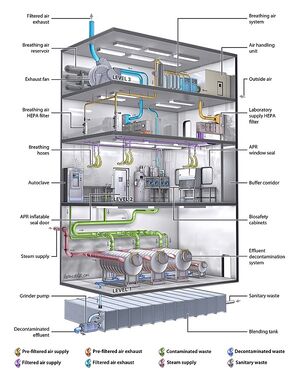
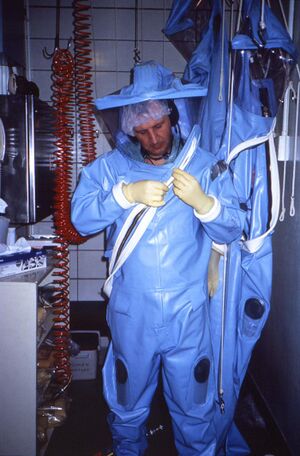
![الفحص المنتظم لبدلات الضغط الإيجابي لتحديد أي تسرب[20]](/w/images/thumb/6/62/NIAID_Integrated_Research_Facility_-_Positive_Pressure_Personnel_Suit_Inspection.jpg/200px-NIAID_Integrated_Research_Facility_-_Positive_Pressure_Personnel_Suit_Inspection.jpg)
![آلة SPECT في مرفق تصوير BSL-4 التي تفصل المواد التي تحتوي على الممرض عن الآلات.[1]](/w/images/thumb/4/43/NIAID_Integrated_Research_Facility_-_SPECT.jpg/200px-NIAID_Integrated_Research_Facility_-_SPECT.jpg)
